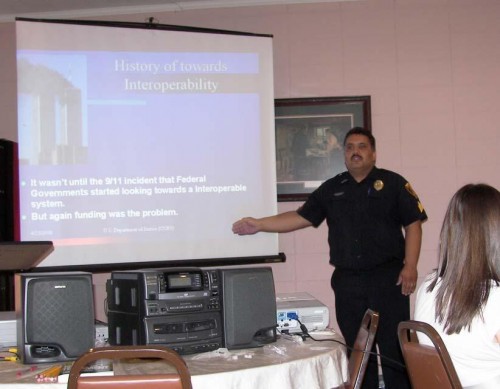
Cleveland Verdin
May 26, 2008
Dr. Charles "Chuck" Binford
May 28, 2008Public safety agencies are onboard with the new wave of interoperable communication, now the Houma Police Department has set its sights on social service sector in Terrebonne and Lafourche parishes.
As it relates to public safety and social service agencies, communication interoperability is the ability to correspond within and across jurisdictions through radio and associated voice, data or video communication during an accident or a natural disaster.
From the early 1950s to the late 1980s all public service agencies were communicating through either a medium- or high-band frequency radio system. But that all changed in the late 1980s when many agencies started buying into the statewide interoperable communication system.
At a cost of $50,000 a year, Louisiana State Police joined the statewide interoperable system in 1980, and has used it for 25 years.
In 2005, the Office of Community Oriented Policing Services, under the U.S. Department of Justice, received more than $90 million in discretionary funds for the 2005 fiscal year to run the Interoperable Communications Technology program.
Of that money, Houma Police received $1.7 million for Terrebonne and Lafourche parishes to implement the interoperable communication system.
Houma Police Sgt. Bobbie O’Bryan, who is spearheading the local transition, said Houma was selected as a potential grant applicant because the 2000 U.S. Census ranked the Terrebonne and Lafourche area to be among the highest populated areas in the state with a population a little over 194,470.
The officer said he is glad to be part of the system because the lack of radio communication between public safety has reached an all time high nationwide.
For the first time in 30 years, Houma Police and the Terrebonne Parish Sheriff’s Office were able to communicate on one radio beginning in 2007.
“This is just the tip of the iceberg. It’s taken 10 years for us to reach this point,” O’Bryan said. “We need to be able to communicate with each other during disasters times.”
Houma Police did a test run of the system during Mardi Gras. The move allowed officers to communicate on one frequency throughout Carnival, O’Bryan said.
“If you are going to have a accident, what better way to try out the system than during Mardi Gras, when things are chaotic in Lafourche and Terrebonne,” he said.
Unfortunately, total compliance to the system has not been reached. Until now, the system has been unavailable to social service entities.
O’Bryan said the need is there. Public safety agencies frequently have to communicate with social service agencies, especially in emergencies.
He is encouraging social service agencies to become a part of the system.
O’Bryan extended an invitation following a presentation detailing enough information about the system to spark an interest at the recent monthly meeting of the Children’s Coalition for the Bayou Region.
“I know this is a lot of information to throw at them at one time, but they need to know what’s available to them,” O’Bryan said.
The cost for local social service agencies to tap into the interoperable system is between $1,500 and $5,000, depending on the type of radio communicator agencies purchase, O’Bryan said.
“To some that may seem like a lot of money, but the advantage outweigh the one-time cost of the system,” he said.
According to O’Bryan, social service agencies would save money with the interoperable communication system instead of paying monthly wireless bills and radio maintenance for employees in the field.
“Most agencies are using wireless carriers like Nextel, Sprint and Verizon, and radios to communicate among themselves,” he said.
“They are paying monthly bills and maintenance services for the radio systems. When you add it all up they could have purchase is an interoperable communication system,” he said.
“They have to look long-term,” O’Bryan added.
Next up for O’Bryan is a meeting with the local Council on Aging, American Red Cross and the Salvation Army. His belief is that more agencies will join the system. Locally, there are 44 entities on the interoperable system in Terrebonne and Lafourche parishes.
For more information, contact O’Bryan at Houma Police at (985) 873-6371 or by e-mail at bobryan@tcpg.org.
Houma Police Sgt. Bobby O’Bryan is spearheading a local program to have all social service providers added to the area’s interoperable communication system. * Photo by SOPHIA RUFFIN










